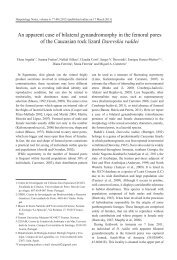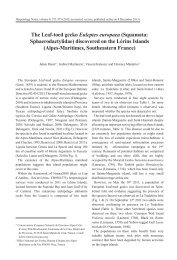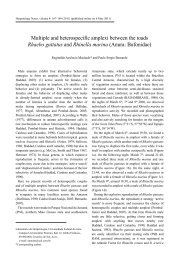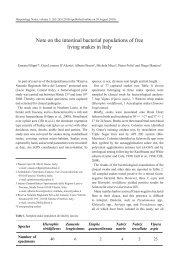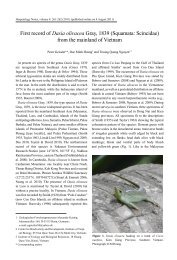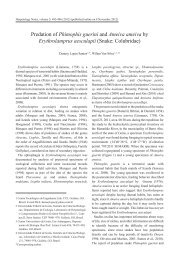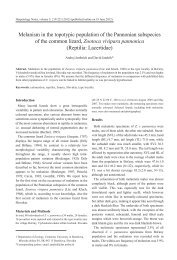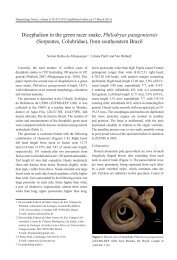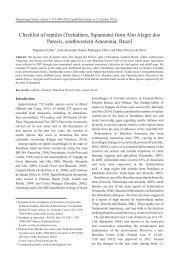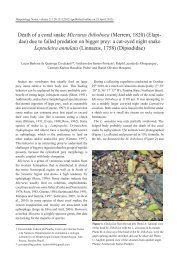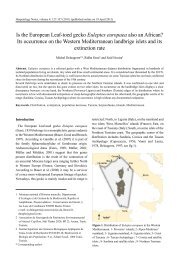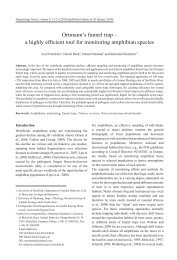External morphology of the tadpoles of the Malagasy treefrog ...
External morphology of the tadpoles of the Malagasy treefrog ...
External morphology of the tadpoles of the Malagasy treefrog ...
You also want an ePaper? Increase the reach of your titles
YUMPU automatically turns print PDFs into web optimized ePapers that Google loves.
Herpetology Notes, volume 5: 325-334 (2012) (published online on 22 August 2012)<br />
<strong>External</strong> <strong>morphology</strong> <strong>of</strong> <strong>the</strong> <strong>tadpoles</strong> <strong>of</strong> <strong>the</strong> <strong>Malagasy</strong> <strong>treefrog</strong><br />
Boophis luteus: ontogenetic variation <strong>of</strong> keratodont numbers and<br />
uniformity between genealogical lineages<br />
Miguel Vences*, Roger-Daniel Randrianiaina, Axel Strauß, David Chinniah Yoheswara, Hannes Beims,<br />
Doreen Donath, Matthias Ebert, Sabine Gebauer, Jacqueline Herrmann, Johannes Klages, Fabian Kollmeier,<br />
Mandy Messal, Clemens Momberg, Susann Parlow, Claudia Zumpe<br />
Abstract. The <strong>Malagasy</strong> <strong>treefrog</strong> Boophis luteus, family Mantellidae, is composed <strong>of</strong> two deeply divergent mitochondrial lineages<br />
(deep conspecific lineages, DCL) which however are uniform in adult <strong>morphology</strong> and advertisement calls. We here provide<br />
a detailed description <strong>of</strong> <strong>the</strong> larval <strong>morphology</strong> <strong>of</strong> <strong>the</strong> sou<strong>the</strong>rn DCL based on specimens identified by DNA barcoding, and<br />
provide detailed morphometric comparisons among <strong>the</strong> two DCL based on 48 <strong>tadpoles</strong>. Univariate and multivariate analyses did<br />
not reveal any significant difference between <strong>the</strong> two DCL, and <strong>the</strong>ir status as intraspecific lineages is <strong>the</strong>refore not challenged.<br />
Keratodont numbers per row and number <strong>of</strong> anterior keratodont rows, were correlated with body size and to a lesser degree with<br />
developmental stage. Hence in <strong>the</strong>se mantellids additional keratodonts are added to each row, and new rows are added, during<br />
tadpole growth, conforming to what probably is a general pattern in anurans.<br />
Keywords. Amphibia, Anura, Mantellidae, Madagascar, keratodonts, larval development.<br />
Introduction<br />
With more than 465 different species and candidate<br />
species <strong>of</strong> frogs (Vieites et al., 2009) Madagascar<br />
is a center <strong>of</strong> species richness <strong>of</strong> <strong>the</strong>se organisms.<br />
Especially in <strong>the</strong> last decade <strong>the</strong> number <strong>of</strong> described<br />
species increased significantly (Vieites et al., 2009).<br />
The delimitation <strong>of</strong> <strong>the</strong>se new species typically<br />
followed an integrative approach including molecular<br />
genetics, bioacoustics and <strong>morphology</strong>, and seeking for<br />
congruence among characters from at least two <strong>of</strong> <strong>the</strong>se<br />
data sets in order to define independent evolutionary<br />
entities. In <strong>the</strong>se studies morphological characters<br />
typically came from adults, but in some cases important<br />
insights were provided by larval characters (Schmidt<br />
et al., 2008; Randrianiaina et al., 2009a; Vences et<br />
Zoological Institute, Technische Universität Braunschweig,<br />
Mendelssohnstr. 4, 38106 Braunschweig, Germany<br />
* Corresponding author, m.vences@tu-bs.de<br />
Note: After Schmidt et al. (2008) and Randrianiaina et al. (2009a)<br />
this is <strong>the</strong> third <strong>of</strong> a series <strong>of</strong> short notes produced within <strong>the</strong> yearly<br />
“Vertebrate <strong>morphology</strong>” undergraduate course at Technische<br />
Universität Braunschweig, with all students <strong>of</strong> <strong>the</strong> course having<br />
contributed to <strong>the</strong> ga<strong>the</strong>ring and analysis <strong>of</strong> data and advised by<br />
senior scientists in <strong>the</strong> statistical interpretation and manuscript<br />
writing.<br />
al., 2010), which are <strong>of</strong>ten insufficiently considered in<br />
taxonomy (Grosjean, 2005).<br />
Besides candidate species, Vieites et al. (2009) also<br />
suggested that deep conspecific lineages (DCL) exist in<br />
<strong>Malagasy</strong> frogs, that is, genealogical lineages showing<br />
deep mitochondrial divergences but not differentiated<br />
at <strong>the</strong> species level. One <strong>of</strong> <strong>the</strong> examples mentioned<br />
was <strong>the</strong> <strong>treefrog</strong> Boophis luteus, a representative <strong>of</strong> <strong>the</strong><br />
family Mantellidae which is distributed among much <strong>of</strong><br />
eastern Madagascar. More recently, Vences et al. (2011)<br />
provided additional data for two Boophis species, and<br />
confirmed for B. luteus <strong>the</strong> presence <strong>of</strong> two DCL and<br />
lack <strong>of</strong> morphological and bioacoustic differentiation<br />
among <strong>the</strong>m. The tadpole <strong>of</strong> B. luteus has been described<br />
by Blommers-Schlösser (1979), and more recently by<br />
Raharivololoniaina et al. (2006) based on specimens<br />
identified by DNA barcoding. However, larval<br />
characters are known only for <strong>the</strong> nor<strong>the</strong>rn B. luteus<br />
DCL (from <strong>the</strong> Andasibe area), and no comparisons<br />
<strong>of</strong> larval <strong>morphology</strong> among populations and between<br />
DCL have so far been undertaken.<br />
When using tadpole characters in <strong>morphology</strong>, it needs<br />
to be considered that <strong>the</strong>se can show an important degree<br />
<strong>of</strong> phenotypic plasticity, but especially, that characters<br />
vary during larval development (Grosjean, 2005). Body<br />
proportions and characters such as <strong>the</strong> development <strong>of</strong><br />
<strong>the</strong> dorsal fin can be influenced by <strong>the</strong> environmental<br />
conditions experienced by a tadpole during growth
326<br />
while o<strong>the</strong>r characters, such as those <strong>of</strong> <strong>the</strong> mouthparts,<br />
are probably less phenotypically plastic (but see Vences<br />
et al., 2002; Su<strong>the</strong>rland, Gouchie and Wassersug,<br />
2009). Several characters <strong>of</strong> <strong>the</strong> mouthparts, such as<br />
<strong>the</strong> number <strong>of</strong> rows <strong>of</strong> labial teeth (keratodont rows),<br />
<strong>the</strong> number and density <strong>of</strong> keratodonts per row, and <strong>the</strong><br />
number <strong>of</strong> oral papillae, are variable between species <strong>of</strong><br />
Boophis and can provide valuable taxonomic characters<br />
(Blommers-Schlösser, 1979; Raharivololoniaina et al.,<br />
2006; Schmidt et al., 2008; Randrianiaina et al., 2009a,<br />
2009b; Rasolonjatovo Hiobiarilanto et al., 2010).<br />
Fur<strong>the</strong>rmore, it is known that <strong>the</strong> number <strong>of</strong> keratodont<br />
rows, keratodont density and number and size <strong>of</strong> papillae<br />
increases during tadpole growth and development (e.g.,<br />
Agarwal and Niazi, 1980; Dutta and Mohanty-Hejmadi,<br />
1984; Grillitsch and Grillitsch, 1989; Tubbs et al., 1993;<br />
Altig and McDiarmid, 1999; Grosjean, 2005), but <strong>the</strong><br />
pattern <strong>of</strong> ontogenetic variation in mantellid frogs, and<br />
particularly in Boophis, has not been studied in detail<br />
thus far.<br />
Here we provide data on <strong>the</strong> <strong>morphology</strong> <strong>of</strong> <strong>tadpoles</strong><br />
<strong>of</strong> Boophis luteus from various localities, with a focus<br />
on (1) detecting morphological differences, or <strong>the</strong>ir<br />
absence, especially in structures <strong>of</strong> <strong>the</strong> oral disks,<br />
among <strong>the</strong> two DCL <strong>of</strong> this species; (2) describing <strong>the</strong><br />
ontogenetic increase in numbers <strong>of</strong> keratodonts and oral<br />
papillae in <strong>the</strong>se larvae.<br />
Materials and Methods<br />
Tadpoles were collected in <strong>the</strong> field, euthanised by immersion<br />
in chlorobutanol solution, and immediately sorted into<br />
homogeneous series based on morphological characters. From<br />
each series one specimen was selected and a tissue sample from<br />
its tail musculature or fin taken and preserved in 99% ethanol.<br />
This specimen is here named “DNA voucher”. All detailed<br />
morphological tadpole characterizations are based on this DNA<br />
voucher, whereas variation is described based on fur<strong>the</strong>r specimens<br />
<strong>of</strong> <strong>the</strong> series. After tissue collection, all specimens were preserved<br />
in 5% formalin or 70% ethanol. Specimens were deposited in<br />
<strong>the</strong> Zoologische Staatssammlung München, Germany (ZSM).<br />
Tadpoles were identified using a DNA barcoding approach. All<br />
molecular methods, and DNA sequences with Genbank accession<br />
numbers, have been reported in Vieites et al. (2009) and Vences<br />
et al. (2011).<br />
Developmental stages are described following Gosner (1960).<br />
Morphological measurements were taken by using a graduated<br />
ocular attached to a stereomicroscope, following landmarks,<br />
terminology and definitions <strong>of</strong> Altig and McDiarmid (1999). The<br />
formula <strong>of</strong> keratodonts (= labial tooth rows) is abbreviated LTRF<br />
and is given according to Altig and McDiarmid (1999).<br />
The following abbreviations are used in <strong>the</strong> description and<br />
in Tables 1 and 2: A 1 (first upper keratodont row), A 2 (second<br />
upper keratodont row), A 3 (third upper keratodont row), A 4<br />
(fourth upper keratodont row), A 5 (fifth upper keratodont row),<br />
Miguel Vences et al.<br />
A 6 (sixth upper keratodont row), A 2 Gap (gap in A 2 ), BL (body<br />
length), BH (maximal body height), BW (maximal body width),<br />
DF (dorsal fin height at midtail), DG (size <strong>of</strong> <strong>the</strong> dorsal gap <strong>of</strong><br />
marginal papillae), DS (developmental stage), ED (eye diameter),<br />
EH (eyes height – measured from <strong>the</strong> lower curve <strong>of</strong> <strong>the</strong> belly),<br />
ESD (distance between eye and spiraculum – measured from<br />
<strong>the</strong> center), HAB (height <strong>of</strong> <strong>the</strong> point where <strong>the</strong> axis <strong>of</strong> <strong>the</strong> tail<br />
myotomes contacts <strong>the</strong> body – measured from <strong>the</strong> lower curve<br />
<strong>of</strong> <strong>the</strong> belly), IND (inter-narial distance - measured from <strong>the</strong><br />
center <strong>of</strong> narial openings), IOD (inter-orbital distance - measured<br />
from <strong>the</strong> center <strong>of</strong> eyes), JW (maximal jaw sheath width), KA 1<br />
(number <strong>of</strong> keratodonts in A 1 ), KA 2 L (number <strong>of</strong> keratodonts in<br />
A 2 L (left)), KA 2 R (number <strong>of</strong> keratodonts in A 2 R (right)), KA 3 L<br />
(number <strong>of</strong> keratodonts in A 3 L), KA 3 R (number <strong>of</strong> keratodonts in<br />
A 3 R), KA 4 L (number <strong>of</strong> keratodonts in A 4 L), KA 4 R (number <strong>of</strong><br />
keratodonts in A 4 R), KA 5 L(number <strong>of</strong> keratodonts in A 5 L), KA 5 R<br />
(number <strong>of</strong> keratodonts in A 5 R), KA 6 L (number <strong>of</strong> keratodonts<br />
in A 6 L), KA 6 R (number <strong>of</strong> keratodonts in A 6 R), KP 1 (number<br />
<strong>of</strong> keratodonts in first posterior (lower) keratodont row (P 1 )),<br />
KP 2 (number <strong>of</strong> keratodonts in second posterior keratodont row<br />
(P 2 )), KP 3 (number <strong>of</strong> keratodonts in third posterior keratodont<br />
row (P 3 )), LTRF (keratodont row formula), MCL (length <strong>of</strong><br />
<strong>the</strong> medial convexity <strong>of</strong> <strong>the</strong> upper sheath), MTH (maximal tail<br />
height), ND (naris diameter), NH (naris height - measured from<br />
<strong>the</strong> lower curve <strong>of</strong> <strong>the</strong> belly), NP (naris-pupil distance), ODW<br />
(maximal oral disc width), RN (rostro-narial distance), SBH<br />
(distance between snout and <strong>the</strong> point <strong>of</strong> maximal body height),<br />
SBW (distance between snout and <strong>the</strong> point <strong>of</strong> maximal body<br />
width), SH (spiraculum height - measured from <strong>the</strong> lower curve<br />
<strong>of</strong> <strong>the</strong> belly to <strong>the</strong> centre <strong>of</strong> <strong>the</strong> spiracle), SL (spiraculum length<br />
– measured from <strong>the</strong> visible edges), SS (snout-spiracle distance),<br />
TAL (tail length), TH (tail height at beginning <strong>of</strong> tail), THM (tail<br />
height at midtail),TMH (tail muscle height at <strong>the</strong> beginning <strong>of</strong> <strong>the</strong><br />
tail), TMHM (tail muscle height at mid-tail), TMW (tail muscle<br />
width), TL (total length), VF (ventral fin height at midtail), VL<br />
(vent tube length).<br />
To test for subtle differences in proportions not detectable by<br />
a simple comparison, we carried out univariate and multivariate<br />
analyses <strong>of</strong> morphometric measurements, in Statistica (version<br />
7.1 StatS<strong>of</strong>t, Tulsa, OK). For <strong>the</strong> multivariate comparisons we<br />
excluded all specimens with missing values, and also excluded<br />
<strong>the</strong> variable ESD which had missing values in too many individual<br />
specimens. Altoge<strong>the</strong>r we took and analyzed measurements <strong>of</strong><br />
15 variables from 48 tadpole specimens, all identified by DNA<br />
barcoding (Tables 1-2). Of <strong>the</strong>se, 41 belong to <strong>the</strong> sou<strong>the</strong>rn DCL<br />
and 7 to <strong>the</strong> nor<strong>the</strong>rn DCL <strong>of</strong> B. luteus. For univariate analysis we<br />
transformed all morphometric measurements into ratios <strong>of</strong> body<br />
length and performed Mann-Whitney U tests. We fur<strong>the</strong>rmore<br />
performed a Principal Component Analysis (PCA) with all<br />
(untransformed) morphometric variables and Varimax rotation,<br />
and constructed scatterplots with <strong>the</strong> resulting PCA factors. To<br />
better understand how keratodonts and keratodont rows are added<br />
during tadpole growth and development we also carried out<br />
non-parametric Spearman correlation analyses <strong>of</strong> size and stage<br />
with <strong>the</strong> number <strong>of</strong> upper keratodont rows and <strong>the</strong> number <strong>of</strong><br />
keratodonts per row. The relations were visualized using simple<br />
scatterplots.
<strong>External</strong> <strong>morphology</strong> <strong>of</strong> Boophis luteus <strong>tadpoles</strong> 327<br />
Results and Discussion<br />
Description <strong>of</strong> B. luteus <strong>tadpoles</strong> belonging to <strong>the</strong><br />
sou<strong>the</strong>rn DCL<br />
The following description refers to one tadpole in<br />
developmental stage Gosner 26 (ZSM 1938/2007;<br />
field number ZCMV 2653, BL 13.1 mm, TL 28 mm,<br />
Genbank accession number JN936176) collected by<br />
R.D. Randrianiaina, and L. Raharivololoniaina on<br />
21 February 2006 in Namorona river at Ranomafana<br />
village (21.26165°S, 47.45952°E, 619 m a. s. l.). The<br />
16S rDNA sequence <strong>of</strong> this specimen was 99% identical<br />
to a reference sequence <strong>of</strong> B. luteus adult specimen<br />
(accession AY848488) from <strong>the</strong> same locality.<br />
In dorsal view, body elliptical, maximal body width<br />
attained between 2/5 and 3/5 <strong>of</strong> body length (SBW<br />
43% <strong>of</strong> BL), snout narrowly rounded. In lateral view,<br />
body depressed (BW 120% <strong>of</strong> BH), maximal body<br />
height attained at 3/5 <strong>of</strong> body length (SBH 69% <strong>of</strong> BL),<br />
snout narrowly rounded. Eyes large (ED 15% <strong>of</strong> BL),<br />
visible from ventral view, positioned high (EH 67% <strong>of</strong><br />
BH) laterally, directed laterally, situated between 3/10<br />
and 4/10 <strong>of</strong> body length (SE 31% <strong>of</strong> BL). Distance<br />
between eyes wide (IOD 73% <strong>of</strong> BW). Nares very large<br />
(ND 2% <strong>of</strong> BL), round, marked with a marginal rim,<br />
positioned high (NH 67% <strong>of</strong> BH) laterally, oriented<br />
ventrally, situated nearer to snout than to eye (RN 57%<br />
<strong>of</strong> NP) and below eye level (NH 80% <strong>of</strong> EH). Distance<br />
between nares moderately wide (IND 45% <strong>of</strong> IOD).<br />
Dark spot posterior to nares present, ornamentation<br />
absent. Spiracle sinistral, long (SL 19% <strong>of</strong> BL), directed<br />
posterodorsally, visible in dorsal and ventral views and<br />
obvious laterally. Its inner wall free from body and<br />
formed such that aperture that opens laterally instead<br />
<strong>of</strong> posteriorly. Opening round, situated between <strong>the</strong> 2/5<br />
and <strong>the</strong> 3/5 <strong>of</strong> <strong>the</strong> tail length (SS 59% <strong>of</strong> BL), located<br />
moderately high on body (SH 31% <strong>of</strong> BH) and below<br />
height <strong>of</strong> contact point <strong>of</strong> axis <strong>of</strong> tail myotomes with body<br />
(SH 54% <strong>of</strong> HAB). Vent tube medial, long (VL 14% <strong>of</strong><br />
BL), with lateral displacement, attached to ventral fin.<br />
No dorsolateral glands visible. Tail short (TAL 162% <strong>of</strong><br />
BL), maximal tail height lower than body height (MTH<br />
92% <strong>of</strong> BH), tail height at midtail lower than body<br />
height and maximal tail height (THM 90% <strong>of</strong> BH and<br />
THM 97% <strong>of</strong> MTH), tail height at <strong>the</strong> beginning <strong>of</strong> <strong>the</strong><br />
tail lower than body height (TH 85% <strong>of</strong> BH). Caudal<br />
musculature developed (TMW 63% <strong>of</strong> BW, TMH 71%<br />
<strong>of</strong> BH, TMH 83% <strong>of</strong> TH and 77% <strong>of</strong> MTH, TMHM<br />
62% <strong>of</strong> THM and 62% <strong>of</strong> MTH). Tail muscle reaches<br />
tail tip. Fins very low (DF 40% <strong>of</strong> TMHM, VF 19% <strong>of</strong><br />
MTHM), dorsal fin higher than ventral fin at mid-tail (DF<br />
217% <strong>of</strong> VF). Dorsal fin originates at dorsal body-tail<br />
junction, upgrades meticulously until 1/4 <strong>of</strong> tail length,<br />
where it ascends rudely to attain maximal tail height,<br />
and <strong>the</strong>n slopes gradually towards tail tip. Ventral fin<br />
originates on caudal musculature just behind vent tube,<br />
extends meticulously until maximal tail height, and<br />
<strong>the</strong>n progresses almost parallel to ventral margin <strong>of</strong> tail<br />
muscle until close to tail tip. Maximal tail height located<br />
between 2/5 and 3/5 <strong>of</strong> tail length (DMTH 43% <strong>of</strong> TAL).<br />
Lateral tail vein recognizable until midtail and myosepta<br />
subtle. Point <strong>of</strong> contact axis <strong>of</strong> tail myotomes with body<br />
located in upper half <strong>of</strong> body (HAB 58% <strong>of</strong> BH), axis<br />
<strong>of</strong> tail myotomes parallel with axis <strong>of</strong> trunk. Tail tip<br />
narrowly rounded. Oral disk generalized, moderately<br />
wide (ODW 55% <strong>of</strong> BW), positioned and directed<br />
ventrally, not emarginated, not visible from dorsal<br />
view, maximal width in <strong>the</strong> middle, upper labium is a<br />
continuation <strong>of</strong> snout. Single row <strong>of</strong> marginal papillae<br />
interrupted by a wide gap on upper labium (DG 78%<br />
<strong>of</strong> ODW), gap on lower labium absent, total number <strong>of</strong><br />
marginal papillae 132. Sixty four submarginal papillae<br />
(32 on right and 32 on left), laterally on lower and upper<br />
labia. Papillae conical, moderately long and large with<br />
protuberated tip. Longest marginal papillae measured<br />
0.16 mm and 0.10 mm for submarginal ones. LTRF 6(2-<br />
6)/2(1). Single row <strong>of</strong> keratondonts per ridge. A 1 very<br />
long (99% <strong>of</strong> ODW). Density <strong>of</strong> keratodonts varies<br />
from 35/mm to 63/mm, KA 1 56/mm (total KA 1 = 205).<br />
Gap in <strong>the</strong> first anterior interrupted row very narrow<br />
(A 2 Gap 5% <strong>of</strong> A 2 ). Rows alignment regular. Keratodont<br />
short (0.15 mm), discernible. Distal keratodont shorter<br />
than those in middle. Large space between marginal<br />
papillae and keratodont rows. Totally keratinized jaw<br />
sheath with moderately strong pointed serrations. Jaw<br />
sheath moderately wide (JW 45% <strong>of</strong> ODW), with very<br />
short narrow pointed (MCL 5% <strong>of</strong> JW) medial convexity<br />
on upper sheath. Lower jaw sheath U-shaped, totally<br />
keratinized and partially hidden by upper jaw sheath.<br />
Coloration in life: Typically brown. Body and tail<br />
covered by brown spots which condense in some areas<br />
to give a dark brown coloration. Slightly transparent<br />
lateral area surrounding body noticeable. A hexagonal<br />
mark above neocranium, a dark semicircular patch<br />
posterior to each narial opening and dark domino-like<br />
structures between vertebral area and abdominal region<br />
obvious. Snout spotted. Dorsum <strong>of</strong> tail muscle blotched.<br />
Myosepta are visible on tail dorsum. Jugal area covered<br />
by dense brown patches, flank dorsolaterally identical to<br />
dorsal pattern, ventrolaterally silvery, abdominal region
328<br />
very dark, leaving a recognisable transparent spiracle.<br />
Laterally, tail musculature orange covered by brown<br />
patches, fins opaque, blood vessels visible on both fins.<br />
Ventrally gular area yellowish, branchial region reddish,<br />
heart hidden by silvery tissue, venter silver, intestinal<br />
coils not visible.<br />
Coloration in preservative: Brown patches in deep<br />
integumental layers (epidermal layer) leaving out<br />
laterally a slightly transparent area surrounding snout<br />
and end <strong>of</strong> belly. Dorsally, brown spots coalesced to<br />
form a hexagonal mark above neocranium, a brown<br />
semicircular patch posterior to each narial opening and<br />
dark patches between vertebral area and abdominal<br />
region. Snout spotted. Myosepta are visible on dorsum<br />
<strong>of</strong> tail musculature. Laterally, jugal area between nares<br />
and eyes covered by dark brown patches and between<br />
eye and spiracle by dark brown scarsed patches, flank<br />
dorsolaterally identical to <strong>the</strong> dorsal pattern, abdominal<br />
region brownish leaving a distinct opaque spiracle,<br />
ventrolaterally whitish. Intestinal coils not visible. Tail<br />
musculature pale and covered by light brown spots which<br />
group to form dense reticulation. Fins transparent, with<br />
few brown spots on <strong>the</strong> dorsal fin, ventral fin almost free<br />
from pigment. Ventrally, oral disk, gular and branchial<br />
regions and venter whitish.<br />
Variation: One Boophis luteus tadpole (ZSM 803/2007<br />
- ZCMV 5081) from Ambatolahy near Ranomafana has<br />
an obvious ventral gap <strong>of</strong> marginal papillae (Fig. 1b).<br />
Absence <strong>of</strong> morphological differentiation between<br />
<strong>tadpoles</strong> belonging to <strong>the</strong> nor<strong>the</strong>rn and sou<strong>the</strong>rn DCL<br />
Our study provides <strong>the</strong> first detailed morphological<br />
data for <strong>the</strong> larvae <strong>of</strong> Boophis luteus from populations<br />
belonging to <strong>the</strong> sou<strong>the</strong>rn DCL, i.e., from Ranomafana<br />
and Vevembe. Compared with <strong>the</strong> detailed description <strong>of</strong><br />
Raharivololoniaina et al. (2006), <strong>the</strong>se <strong>tadpoles</strong> showed<br />
no constant differences in coloration, body proportions<br />
or mouthpart structures.<br />
Mann-Whitney U tests resulted in only one variable<br />
(VF) having a significant difference between <strong>the</strong> two<br />
DCL (P=0.023) but this significance was not maintained<br />
after Bonferroni correction for 15 seperate tests (15<br />
variables).<br />
In PCA (Table 3) <strong>the</strong> first factor had strong and<br />
unidirectional loadings for all characters, thus being<br />
mostly influenced by size, and was not considered<br />
fur<strong>the</strong>r. Factors 2, 3 and 4 explained 8.5%, 3.5% and<br />
2.7% <strong>of</strong> <strong>the</strong> total variance (Table 3).<br />
Scatterplots based on factors 2 and 3 (Fig. 2b), and<br />
Miguel Vences et al.<br />
Figure 1. Oral disk <strong>of</strong> <strong>tadpoles</strong> <strong>of</strong> Boophis luteus from <strong>the</strong><br />
Ranomafana region. (a) ZSM 1938/2007; (b) ZSM 803/2007.<br />
Note small posterior gap in marginal papillae in (b) as marked<br />
by an arrow.<br />
2 and 4 (not shown) <strong>of</strong> PCA suggested no separation<br />
between <strong>the</strong> <strong>tadpoles</strong> belonging to different DCL; <strong>the</strong><br />
less numerous specimens <strong>of</strong> <strong>the</strong> nor<strong>the</strong>rn DCL (black<br />
crosses) were placed completely within <strong>the</strong> cloud <strong>of</strong><br />
points representing specimens <strong>of</strong> <strong>the</strong> sou<strong>the</strong>rn DCL.<br />
Plots <strong>of</strong> various morphometric measurements vs. BL<br />
suggested clear and largely linear correlations, without<br />
visually detectable differences in <strong>tadpoles</strong> belonging to<br />
<strong>the</strong> two DCL (shown in Fig. 2c and 2d for BH and TAL,<br />
respectively; two important measurements <strong>of</strong> general<br />
body proportions). Similar size-dependence was found<br />
for keratodont counts and will be discussed in <strong>the</strong><br />
following section; also in keratodont values, <strong>the</strong>re was<br />
no difference between <strong>the</strong> two DCL (Fig. 3). Equally,<br />
no difference between <strong>the</strong> two DCL was detected in <strong>the</strong><br />
relation <strong>of</strong> body size vs. developmental stage (Fig. 2a).<br />
Consequently, tadpole data do not provide any<br />
indication for morphological differentiation <strong>of</strong> <strong>the</strong><br />
nor<strong>the</strong>rn and sou<strong>the</strong>rn DCL <strong>of</strong> Boophis luteus. Due to <strong>the</strong><br />
absence <strong>of</strong> morphological and bioacoustic differences<br />
between adults, Vences et al. (2011) concluded that<br />
<strong>the</strong>se two genealogical lineages should best be seen as<br />
intraspecific units, and contrary to <strong>the</strong> situation in B.<br />
boehmei and B. quasiboehmei (Vences et al., 2010),<br />
larval <strong>morphology</strong> provides no arguments to reverse<br />
this view.
<strong>External</strong> <strong>morphology</strong> <strong>of</strong> Boophis luteus <strong>tadpoles</strong> 329<br />
Figure 2. Results <strong>of</strong> univariate and multivariate morphometric analyses <strong>of</strong> Boophis luteus <strong>tadpoles</strong>. Grey circles are specimens<br />
from <strong>the</strong> Ranomafana region (sou<strong>the</strong>rn DCL), black crosses are specimens from <strong>the</strong> Andasibe region (nor<strong>the</strong>rn DCL). No obvious<br />
differences between <strong>the</strong> two DCL are revealed in body size vs. developmental stage (a). Body height (c) and tail length (d) are<br />
closely correlated with body length, but no differences in this relationship are recognizable between <strong>the</strong> two DCL. Similarly,<br />
factors 2 and 3 <strong>of</strong> a Principal Component Analysis (b) show a full overlap in morphospace among <strong>the</strong> two DCL (see Table 3 for<br />
factor loadings <strong>of</strong> PCA).<br />
Ontogenetic variation <strong>of</strong> keratodont numbers<br />
All Boophis luteus <strong>tadpoles</strong> examined have <strong>the</strong> first<br />
anterior keratodont row complete and all following<br />
anterior keratodont rows interrupted. These interrupted<br />
anterior keratodont rows range between 2 and 6. Already<br />
a superficial look at <strong>the</strong> original data (Table 2) suggests<br />
an influence <strong>of</strong> tadpole size on <strong>the</strong> number <strong>of</strong> anterior<br />
keratodont rows, as <strong>the</strong> highest numbers <strong>of</strong> 5 interrupted<br />
rows were exclusively found in ra<strong>the</strong>r large specimens<br />
(> 10 mm BL; see Fig. 3). All <strong>tadpoles</strong> examined had<br />
three posterior keratodont rows, <strong>of</strong> which typically <strong>the</strong><br />
first had a small medial gap and was <strong>the</strong>refore scored as<br />
interrupted (Table 2); however, in a few specimens, this<br />
medial gap was not recognizable, and <strong>the</strong> row was thus<br />
scored as complete.<br />
The number <strong>of</strong> keratodonts on all anterior and<br />
posterior rows except A 6 (which were present in only<br />
six specimens) were significantly correlated with<br />
developmental stage and with body length (nonparametric<br />
Spearman correlation; P
330<br />
Miguel Vences et al.<br />
Figure 3. Relation <strong>of</strong> keratodonts, body length and developmental stage in <strong>tadpoles</strong> <strong>of</strong> Boophis luteus. Symbols as in Fig. 2.<br />
Selected keratodont counts (number <strong>of</strong> keratodonts on first posterior and first anterior row (a-d) and number <strong>of</strong> anterior keratodont<br />
rows (e-f) are correlated in a roughly linear fashion with body size. No obvious differences are revealed between <strong>the</strong> two DCL.
<strong>External</strong> <strong>morphology</strong> <strong>of</strong> Boophis luteus <strong>tadpoles</strong> 331<br />
significant after Bonferroni correction). The total<br />
number <strong>of</strong> anterior rows was positively correlated<br />
(P
332<br />
Vences, M., Puente, M., Nieto, S., Vieites, D.R. (2002): Phenotypic<br />
plasticity <strong>of</strong> anuran larvae: environmental variables influence<br />
body shape and oral <strong>morphology</strong> in Rana temporaria<br />
<strong>tadpoles</strong>. Journal <strong>of</strong> Zoology, London 257: 155–162.<br />
Miguel Vences et al.<br />
Vieites, D.R., Wollenberg, K.C., Andreone, F., Köhler, J., Glaw,<br />
F., Vences, M. (2009): Vast underestimation <strong>of</strong> Madagascar’s<br />
biodiversity evidenced by an integrative amphibian inventory.<br />
Proceedings <strong>of</strong> <strong>the</strong> National Academy <strong>of</strong> Sciences <strong>of</strong> <strong>the</strong><br />
U.S.A. 106: 8267–8272.<br />
Table 1. Morphometric measurements in examined <strong>tadpoles</strong> <strong>of</strong> Boophis luteus. All values in mm except DCL (number <strong>of</strong> deep<br />
conspecific lineage) and DS (developmental stage). For abbreviations, see Materials and Methods; additional abbreviations: nm,<br />
not measured. DCL, deep conspecific lineage (DCL 1, sou<strong>the</strong>rn central east and south east; DCL 2, nor<strong>the</strong>rn central east <strong>of</strong><br />
Madagascar).<br />
Catalogue Locality DCL DS BL BH BW TL TAL TMH TMW MTH DF TMHM VF ODW ED IOD IND ESD<br />
Number<br />
ZSM 0329/2007 Ranomafana 1 25 8.3 3.8 4.6 20.2 12.0 3.1 2.5 1.9 0.5 2.7 0.3 2.7 1.3 3.3 1.4 2.2<br />
ZSM 0343/2007 Ranomafana 1 25 8.4 3.4 4.2 20.1 12.4 1.8 1.8 2.5 0.7 1.0 0.9 2.6 1.0 3.0 1.4 2.6<br />
ZSM 0406/ 2007 Ranomafana 1 25 5.3 2.0 2.8 13.2 7.9 1.7 1.1 1.8 1.4 1.2 0.6 1.4 0.6 1.7 1.1 1.5<br />
ZSM 0409/2007 Ranomafana 1 26 9.5 3.5 4.8 20.1 11.5 1.8 1.6 2.3 0.4 0.9 1.0 2.6 0.9 2.7 1.6 2.6<br />
ZSM 0479/2008 Ranomafana 1 28 10.3 5.0 5.3 26.7 16.8 3.6 3.5 3.9 2.4 2.2 1.7 2.4 1.8 4.5 1.9 1.9<br />
ZSM 0481/2007 Ranomafana 1 27 11.9 4.0 5.3 22.9 12.2 2.9 2.7 3.4 1.3 1.2 0.8 2.2 1.0 3.4 1.7 3.3<br />
ZSM 0665/2007 Ranomafana 1 25 4.6 2.2 2.5 9.7 5.2 1.7 0.8 2.0 0.4 1.3 0.4 0.6 0.5 1.6 0.7 1.3<br />
ZSM 0698/2007 Ranomafana 1 25 5.6 2.7 3.3 nm nm 1.1 1.4 3.3 0.7 2.2 0.3 1.4 0.8 1.9 1.2 1.2<br />
ZSM 0783/2007 Ranomafana 1 25 6.1 2.6 3.3 14.9 8.6 1.6 1.3 1.7 0.3 0.8 0.5 1.3 0.8 1.7 0.8 1.8<br />
ZSM 0818/2007 Ranomafana 1 25 5.5 2.3 3.0 11.4 5.5 1.3 1.6 1.8 0.1 1.3 0.4 1.6 0.8 2.2 0.5 nm<br />
ZSM 0828/2007 Ranomafana 1 27 6.5 3.4 3.6 14.6 9.8 1.4 1.2 2.1 0.8 0.8 0.5 1.6 0.6 2.2 0.0 2.0<br />
ZSM 0831/2007 Ranomafana 1 25 7.2 2.6 3.3 15.0 9.2 1.5 1.8 2.8 1.0 1.0 0.8 1.5 0.7 2.0 1.3 1.2<br />
ZSM 0833/2007 Ranomafana 1 25 5.4 2.7 3.1 15.4 10.0 1.4 0.9 2.0 0.5 0.8 0.7 1.4 0.7 1.8 0.9 2.0<br />
ZSM 0834/2007 Ranomafana 1 25 9.0 4.0 4.0 22.4 13.6 2.3 2.0 3.5 1.4 0.9 1.2 2.6 0.9 3.5 1.6 2.6<br />
ZSM 0835/2007 Ranomafana 1 25 7.1 3.2 3.6 15.6 8.0 1.5 1.3 2.4 0.8 1.1 0.4 1.6 0.7 2.4 1.3 1.8<br />
ZSM 0840/2007 Ranomafana 1 27 8.9 4.0 5.0 22.0 14.6 3.3 1.9 3.0 0.9 1.5 0.6 2.1 1.1 2.8 1.5 2.3<br />
ZSM 0844/2007 Ranomafana 1 25 7.0 2.7 3.6 13.6 7.8 1.1 1.3 2.6 0.6 1.5 0.7 1.8 0.9 1.9 0.9 1.1<br />
ZSM 0849/2007 Ranomafana 1 25 5.4 2.0 2.5 14.2 7.6 1.3 0.7 2.0 0.5 1.0 0.3 1.6 0.7 2.3 1.0 1.9<br />
ZSM 0856/2007 Ranomafana 1 25 8.9 4.2 4.8 22.7 13.2 2.3 1.4 3.4 0.9 0.9 1.2 1.7 1.0 3.0 1.6 3.1<br />
ZSM 0858/2007 Ranomafana 1 25 4.6 2.0 2.4 12.4 6.0 1.0 1.3 2.2 0.4 1.3 0.5 0.9 0.6 1.6 0.5 1.3<br />
ZSM 0859/2007 Ranomafana 1 27 11.6 4.4 6.3 27.8 17.3 2.3 2.2 4.6 1.2 1.6 1.7 3.5 1.3 3.9 2.2 3.6<br />
ZSM 0860/2007 Ranomafana 1 25 7.5 3.0 4.0 16.1 9.7 3.6 1.2 3.5 0.8 1.1 0.9 3.6 1.0 2.6 1.5 2.0<br />
ZSM 0865/2007 Ranomafana 1 26 7.4 3.4 4.4 20.8 12.7 1.4 1.8 3.6 1.3 0.9 1.4 2.0 0.8 2.8 1.4 2.4<br />
ZSM 0877/2007 Ranomafana 1 28 11.2 6.2 7.2 30.3 18.9 3.5 3.1 4.9 2.0 2.0 1.0 3.5 1.6 4.6 2.0 4.3<br />
ZSM 0933/2007 Ranomafana 1 26 7.9 4.0 4.4 16.5 9.5 2.0 1.8 2.5 0.4 1.2 0.9 1.8 0.8 2.8 1.1 2.1<br />
ZSM 0999/2007 Ranomafana 1 25 7.4 3.5 4.2 17.2 10.0 1.8 1.7 2.6 0.8 0.8 1.2 2.0 0.9 2.8 1.7 2.3<br />
ZSM 1089/2007 Ranomafana 1 25 7.4 2.0 3.3 14.0 7.3 1.1 1.0 2.8 1.0 1.0 0.7 1.0 0.4 1.7 0.9 1.6<br />
ZSM 1290/2007 Ranomafana 1 25 8.3 3.9 4.7 19.3 11.6 2.5 1.6 3.6 1.2 1.2 1.3 2.2 0.9 3.0 2.5 1.4<br />
ZSM 1292/2004 Ranomafana 1 28 13.4 6.0 7.5 8.0 21.4 2.1 4.4 6.0 1.0 4.1 0.2 2.4 2.5 4.3 2.3 nm<br />
ZSM 1303/2004 Ranomafana 1 25 7.5 3.4 3.9 15.3 8.9 2.1 1.8 2.1 0.4 1.2 0.5 2.2 0.4 2.7 1.3 1.6<br />
ZSM 1349/2004 Ranomafana 1 41 14.3 5.7 8.1 37.1 24.5 3.9 3.9 4.9 1.0 3.1 0.8 3.9 2.1 5.6 2.6 4.9<br />
ZSM 1350/2004 Ranomafana 1 27 12.5 5.2 6.4 33.7 21.8 1.5 4.4 4.6 1.0 3.3 0.7 4.2 1.2 3.9 2.4 nm<br />
ZSM 1352/2004 Ranomafana 1 28 11.3 5.3 6.1 33.7 20.9 4.2 4.2 4.7 1.0 3.4 0.6 3.1 1.0 4.0 2.2 nm<br />
ZSM 1355/2004 Ranomafana 1 25 7.5 2.9 3.5 nm nm 2.1 1.3 nm nm nm nm 2.0 0.4 2.7 1.4 0.8<br />
ZSM 1359/2004 Ranomafana 1 25 8.5 3.9 4.6 nm nm 2.6 2.3 nm nm 2.3 nm 2.8 0.1 3.5 1.5 1.3<br />
ZSM 1360/2004 Ranomafana 1 26 9.3 3.9 3.1 24.5 15.1 1.7 1.8 4.1 1.2 1.3 0.9 1.5 0.5 3.3 1.8 1.3<br />
ZSM 1364/2004 Ranomafana 1 25 7.6 3.6 4.2 17.2 11.0 2.5 2.1 2.9 0.9 1.4 0.6 1.7 0.7 2.9 1.5 1.3<br />
ZSM 1367/2004 Ranomafana 1 25 5.8 2.2 3.0 14.4 6.9 1.9 1.6 2.3 0.7 1.1 0.4 1.6 0.9 2.2 1.2 nm<br />
ZSM 1931/2007 Ranomafana 1 37 13.1 5.6 6.7 34.5 21.3 3.9 4.2 5.1 1.3 3.2 0.6 3.7 2.1 5.3 2.4 nm<br />
ZSM 803/2007 Ranomafana 1 35 13.2 5.6 7.0 27.6 20.6 3.5 3.8 5.7 1.9 2.5 1.0 4.0 1.8 5.2 2.6 nm<br />
ZSM 1386/2004 Vevembe 1 38 13.6 7.0 8.6 36.5 22.6 4.8 4.4 6.6 2.2 2.7 1.6 5.0 2.2 4.7 2.6 2.6<br />
ZSM 1709/2007 Mandraka 2 25 8.6 3.6 4.7 20.8 12.5 2.4 1.7 3.3 1.3 1.1 0.6 2.5 1.1 2.8 1.2 2.6<br />
ZSM 1764/2007 AnAla 2 26 11.7 5.3 7.0 26.6 14.9 3.3 2.6 4.2 1.4 1.8 0.8 3.4 1.2 3.9 2.3 2.6<br />
ZSM 1788/2007 AnAla 2 25 9.9 5.2 7.8 25.9 15.4 2.5 3.2 3.6 1.3 1.6 0.4 3.2 1.3 3.7 2.2 3.2<br />
ZSM 538/2004 Andasibe 2 35 12.0 4.9 5.0 28.2 18.0 2.8 3.0 4.2 2.3 2.8 0.7 2.2 1.5 4.6 1.5 3.3<br />
ZSM 539/2004 Andasibe 2 27 10.3 4.4 5.7 28.7 18.5 3.2 3.1 3.6 0.8 2.1 0.5 3.7 1.6 3.6 2.0 3.2<br />
ZSM 541/2004 Andasibe 2 29 11.8 5.2 6.4 34.9 21.9 4.0 4.0 4.2 0.8 3.3 0.9 3.0 1.6 4.8 1.6 4.6<br />
ZSM 542/2004 Andasibe 2 38 15.8 6.2 9.3 40.7 24.7 4.6 4.8 6.4 2.0 2.7 1.3 3.9 2.3 5.2 2.0 5.2
<strong>External</strong> <strong>morphology</strong> <strong>of</strong> Boophis luteus <strong>tadpoles</strong> 333<br />
Table 2. Keratodont counts in examined <strong>tadpoles</strong> <strong>of</strong> Boophis luteus. For abbreviations, see Materials and Methods; additional<br />
abbreviations: na, not applicable (keratodont row does not exist or is obviously damaged); nm, not measured. DCL, deep<br />
conspecific lineage (DCL 1, sou<strong>the</strong>rn central east and south east; DCL 2, nor<strong>the</strong>rn central east <strong>of</strong> Madagascar).<br />
Catalogue Locality DCL KA1 KA2L KA2R KA3L KA3R KA4L KA4R KA5L KA5R KA6L KA6R KP1 KP2 KP3 LTRF<br />
Number<br />
ZSM 0329/2007 Ranomafana 1 131 63 55 43 46 29 31 22 26 na na 92 92 123 1:4+4/1+1:2<br />
ZSM 0343/2007 Ranomafana 1 139 66 65 57 45 44 39 31 31 na na 88 95 126 1:4+4/1+1:2<br />
ZSM 0406/ 2007 Ranomafana 1 58 25 25 20 15 na na na na na na 35 47 50 1:2+2/1+1:2<br />
ZSM 0409/2007 Ranomafana 1 132 59 51 39 42 42 34 24 30 na 4 90 96 75 1:4+4/1+1:2<br />
ZSM 0479/2008 Ranomafana 1 140 62 76 61 61 34 43 18 16 na na 107 131 150 1:4+4/3<br />
ZSM 0481/2007 Ranomafana 1 148 74 85 54 59 45 47 35 40 na na 104 119 136 1:4+4/1+1:2<br />
ZSM 0665/2007 Ranomafana 1 27 2 3 na na na na na na na na nm 18 nm nm<br />
ZSM 0698/2007 Ranomafana 1 28 10 12 9 10 na na na na na na 19 24 24 1:3+3/1+1:2<br />
ZSM 0783/2007 Ranomafana 1 84 43 46 30 37 22 18 na na na na 68 82 86 1:3+3/1+1:2<br />
ZSM 0818/2007 Ranomafana 1 77 42 33 32 30 22 26 10 na na na 57 78 83 1:4+4/1+1:2<br />
ZSM 0828/2007 Ranomafana 1 117 50 44 43 43 35 26 na 11 na na 83 89 93 1:3+3/1+1:2<br />
ZSM 0831/2007 Ranomafana 1 124 53 50 38 43 36 30 19 19 na na 72 90 91 1:4+4/1+1:2<br />
ZSM 0833/2007 Ranomafana 1 92 35 42 37 34 21 25 9 11 na na 64 79 85 1:4+4/1+1:2<br />
ZSM 0834/2007 Ranomafana 1 132 57 58 43 52 34 34 26 30 na na 83 98 120 1:4+4/1+1:2<br />
ZSM 0835/2007 Ranomafana 1 130 54 53 33 40 28 37 14 15 na na 82 91 79 1:4+4/1+1:2<br />
ZSM 0840/2007 Ranomafana 1 126 55 52 42 50 40 43 28 30 na na 92 95 93 1:4+4/1+1:2<br />
ZSM 0844/2007 Ranomafana 1 nm 41 45 na 37 na na na na na na na na na 1:2+2/1+1:2<br />
ZSM 0849/2007 Ranomafana 1 117 47 44 35 36 30 29 20 22 na na 74 82 88 1:4+4/1+1:2<br />
ZSM 0856/2007 Ranomafana 1 134 57 54 43 41 35 34 21 25 na na 83 92 98 1:4+4/1+1:2<br />
ZSM 0858/2007 Ranomafana 1 65 24 24 8 8 na na na na na na 28 47 32 1:2+2/1+1:2<br />
ZSM 0859/2007 Ranomafana 1 169 67 62 53 51 44 42 26 24 na na 103 120 123 1:4+4/1+1:2<br />
ZSM 0860/2007 Ranomafana 1 135 53 51 49 44 36 40 20 22 na na 87 101 114 1:4+4/1+1:2<br />
ZSM 0865/2007 Ranomafana 1 142 57 58 47 51 40 38 28 30 na na 84 100 113 1:4+4/1+1:2<br />
ZSM 0877/2007 Ranomafana 1 163 51 64 55 60 47 45 24 39 na na 121 138 163 1:4+4/1+1:2<br />
ZSM 0933/2007 Ranomafana 1 109 47 46 40 40 30 27 18 18 na na 82 95 107 1:4+4/1+1:2<br />
ZSM 0999/2007 Ranomafana 1 66 46 54 36 39 22 26 11 na na na 67 84 71 1:4+4/1+1:2<br />
ZSM 1089/2007 Ranomafana 1 >61 nm 44 nm 37 nm 30 nm 16 na na 79 81 95 1:3+3/3<br />
ZSM 1290/2007 Ranomafana 1 nm nm nm nm nm nm nm nm nm nm nm nm nm nm 1:4+4/3<br />
ZSM 1292/2004 Ranomafana 1 nm nm nm nm nm nm nm nm nm nm nm nm nm nm 1:4+4/1+1:2<br />
ZSM 1303/2004 Ranomafana 1 111 55 51 48 43 na na na na na na nm nm nm 1:2+2/1+1/2<br />
ZSM 1350/2004 Ranomafana 1 nm nm nm nm nm nm nm nm nm nm nm nm nm nm 1:4+4/3<br />
ZSM 1352/2004 Ranomafana 1 nm nm nm nm nm nm nm nm nm nm nm nm nm nm 1:4+4/1+1:2<br />
ZSM 1355/2004 Ranomafana 1 nm nm nm nm nm nm nm nm nm nm nm nm nm nm 1:3+3/1+1:2<br />
ZSM 1364/2004 Ranomafana 1 nm nm nm nm nm nm nm nm nm nm nm nm nm nm 1:4+4/1+1:2<br />
ZSM 1367/2004 Ranomafana 1 nm nm nm nm nm nm nm nm nm nm nm nm nm nm 1:4+4/1+1:2<br />
ZSM 1931/2007 Ranomafana 1 239 94 96 70 68 60 60 51 52 3 4 163 196 223 1:5+5/1+1:2<br />
ZSM 803/2007 Ranomafana 1 193 99 96 70 70 56 53 43 41 6 4 148 190 214 1:5+5/1+1:2<br />
ZSM 1386/2004 Vevembe 1 172 91 88 72 73 60 61 na na na na 74 157 172 1:2+2/2+2:1<br />
ZSM 1709/2007 Mandraka 2 109 62 54 42 42 24 37 22 11 na na na 99 89 1:4+4/1+1:2<br />
ZSM 1764/2007 AnAla 2 206 95 95 72 75 51 60 52 49 34 26 143 159 151 1:5+5/1+1:2<br />
ZSM 1788/2007 AnAla 2 185 39 74 48 64 37 41 31 26 na na 125 147 164 1:4+4/1+1:2<br />
ZSM 538/2004 Andasibe 2 170 78 81 62 68 51 52 42 32 na na 130 155 158 1:4+4/1+1:2<br />
ZSM 539/2004 Andasibe 2 175 78 69 64 77 39 59 26 27 na na 112 140 181 1:4+4/1+1:2<br />
ZSM 541/2004 Andasibe 2 153 78 93 75 75 53 69 47 51 29 24 101 106 143 1:5+5/1+1:2<br />
ZSM 542/2004 Andasibe 2 174 111 106 79 84 64 62 60 55 40 37 175 189 232 1:5+5/1+1:2
334<br />
Factor 1 Factor 2 Factor 3 Factor 4<br />
BL -0.96325 0.027773 0.020584 0.089372<br />
BH -0.96133 0.013618 0.014068 0.029476<br />
BW -0.94575 0.046540 -0.058815 0.082672<br />
TL -0.87613 -0.121623 -0.250275 -0.206070<br />
TAL -0.96623 0.079183 -0.007086 0.035237<br />
TMH -0.83773 -0.019773 -0.175610 -0.422463<br />
TMW -0.93723 0.233315 0.061429 0.011970<br />
MTH -0.93454 -0.076811 0.170223 0.127278<br />
DF -0.69616 -0.439374 0.464875 -0.213415<br />
TMHM -0.79776 0.496434 0.143438 0.023578<br />
VF -0.40691 -0.848848 -0.068051 0.136837<br />
ODW -0.87969 -0.022447 -0.328699 0.029576<br />
ED -0.89467 0.156576 0.159854 0.018802<br />
IOD -0.96371 0.028293 0.011043 -0.046570<br />
IND -0.86010 -0.088930 -0.111634 0.295025<br />
Expl.Var 11.43067 1.278681 0.517851 0.409478<br />
Prp.Totl 0.76204 0.085245 0.034523 0.027299<br />
Eigenvalue 11.43067 1.27868 0.51785 0.40948<br />
% Total variance 76.20445 8.52454 3.45234 2.72985<br />
Cumulative<br />
11.43067 12.70935 13.22720 13.63668<br />
Eigenvalue<br />
Cumulative % Total<br />
variance<br />
76.20445 84.72899 88.18133 90.91118<br />
Miguel Vences et al.<br />
Table 3. Factor loadings from a Principal Component Analysis <strong>of</strong> morphometric variables in <strong>tadpoles</strong> <strong>of</strong> Boophis luteus (data from<br />
Table 1; variable ESD excluded).<br />
Accepted by Angelica Crottini



